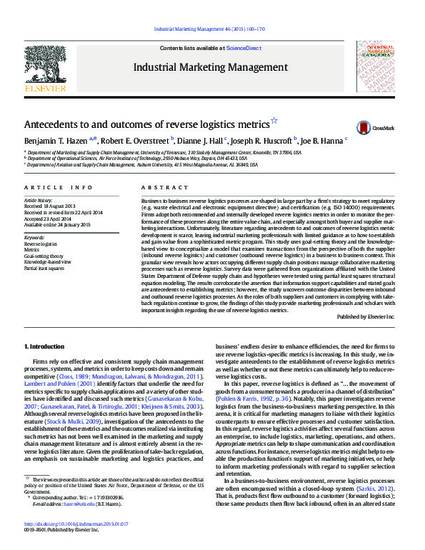
Article
Antecedents to and outcomes of reverse logistics metrics
Industrial Marketing Management
(2015)
Abstract
Business to business reverse logistics processes are shaped in large part by a firm's strategy to meet regulatory (e.g. waste electrical and electronic equipment directive) and certification (e.g. ISO 14000) requirements. Firms adopt both recommended and internally developed reverse logistics metrics in order to monitor the performance of these processes along the entire value chain, and especially amongst both buyer and supplier marketing interactions. Unfortunately, literature regarding antecedents to and outcomes of reverse logistics metric development is scarce, leaving industrial marketing professionals with limited guidance as to how to establish and gain value from a sophisticated metric program.This study uses goal-setting theory and the knowledge-based view to conceptualize a model that examines transactions from the perspective of both the supplier (inbound reverse logistics) and customer (outbound reverse logistics) in a business to business context. This granular view reveals how actors occupying different supply chain positions manage collaborative marketing processes such as reverse logistics. Survey data were gathered from organizations affiliated with the United States Department of Defense supply chain and hypotheses were tested using partial least squares structural equation modeling. The results corroborate the assertion that information support capabilities and stated goals are antecedents to establishing metrics; however, the study uncovers outcome disparities between inbound and outbound reverse logistics processes. As the roles of both suppliers and customers in complying with take-back regulation continue to grow, the findings of this study provide marketing professionals and scholars with important insights regarding the use of reverse logistics metrics.
Keywords
- Reverse logistics,
- Metrics,
- Goal-setting theory,
- Knowledge-based view,
- Partial least squares
Disciplines
Publication Date
April, 2015
DOI
10.1016/j.indmarman.2015.01.017
Publisher Statement
Works produced by employees of the U.S. Government as part of their official duties are not copyrighted within the U.S. The content of this document is not copyrighted.
Citation Information
Benjamin T. Hazen, Robert E. Overstreet, Dianne J. Hall, Joseph R. Huscroft, et al.. "Antecedents to and outcomes of reverse logistics metrics" Industrial Marketing Management Vol. 46 (2015) p. 160 - 170 Available at: http://works.bepress.com/robert-overstreet/13/
